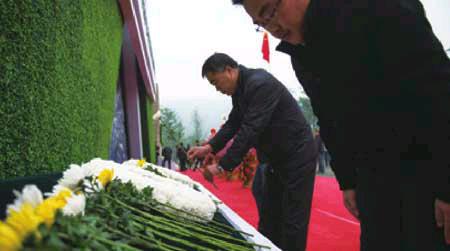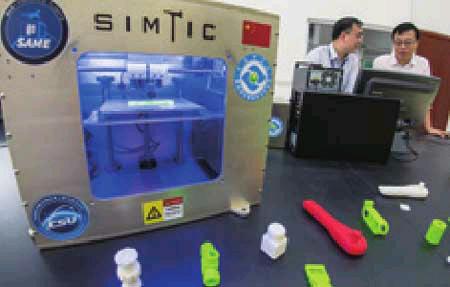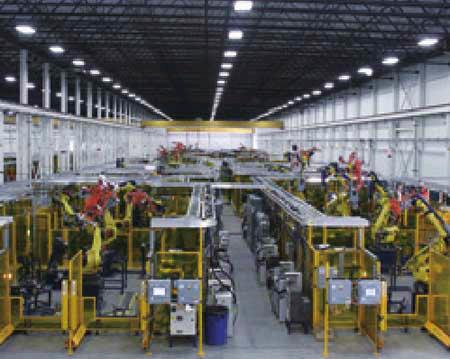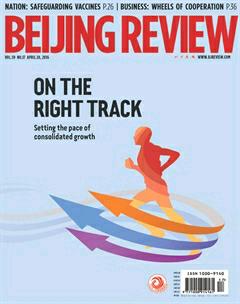Observing the Anniversary
2016-05-04
Local residents mourn at a monument in Lushan County, southwest Chinas Sichuan Province. The ceremony on April 20 was in remembrance of the 196 people who died in a devastating earthquake on the same day three years ago.
Pension Raise
Since the beginning of this year, the general level of monthly payment for pensioners from enterprises, government agencies and public institutions has been lifted by 6.5 percent from 2015, said a statement by the Ministry of Human Resources and Social Security and Ministry of Finance on April 15.
The improvement marked the 12th straight year of pension rises.
To set the level, multiple factors are considered, including economic growth, workers incomes and fiscal revenues, according to the statement.
Urban Settlement
China will ease household relocation policies to help more migrants settle in cities, said Xu Lin, an official with the National Development and Reform Commission (NDRC), at a press conference on April 19.
During the 13th Five-Year Plan(2016-20) period, the Chinese Government plans to raise the proportion of registered permanent urban residents to total population to 45 percent from less than 40 percent in 2015.
To achieve the goal, around 100 million migrants need to be granted with urban household registration, Xu said. He added that local authorities, especially in major cities, have been asked to loosen household relocation restrictions this year.
Meanwhile, the government will fully implement the urban residence permit system this year to help rural migrant workers enjoy equal public services in cities, Xu said.
Chinas urban areas have been expanding rapidly with many migrant workers swarming into cities after decades of economic development. A top-level urban work conference held at the end of 2015 stressed that the countrys urbanization drive will focus on the integration of rural residents into urban areas.
Reading Trends
A national survey found that cellphones have become the favored way to read media in China.
About 64 percent of adults read digitally in 2015, up 5.9 percentage points, while 58.4 percent read paper books, only a 0.4-percentage-point increase, according to findings of the annual survey that were released on April 19.
The survey, conducted by the Chinese Academy of Press and Publication, polled 45,911 adults in 29 provincial-level regions. It revealed that 60 percent of respondents read on their mobile phones in 2015, up 8.2 percentage points than the previous year.
On average, readers read 3.26 e- books, while 4.58 paper books were read per capita in 2015.
Chinese people spend more time reading on their digital devices than paper books. More than 60 minutes was spent reading on mobile phones each day in 2015, compared with 33 minutes per day in 2014.
Embryos in Space
Chinese scientists on April 17 said that they have successfully developed early-stage mouse embryos in space for the first time on a retrievable microgravity satellite, which returned to Earth on April 18.
The SJ-10 research probe, launched on April 6, carried over 6,000 mouse embryos in a selfsufficient chamber the size of a microwave oven, according to Duan Enkui, a researcher with the Chinese Academy of Sciences.
Among them, 600 embryos were put under a high-resolution camera, which took pictures every four hours for four days and sent them back to Earth.
The pictures showed that the embryos developed from the 2-cell stage, an early-on embryonic cleavage stage, to blastocyst, the stage where noticeable cell differentiation occurs, around 72 hours after SJ-10s launch, Duan said. The timing was largely in line with embryonic development on Earth, he added.
The rest of the embryos loaded on the satellite were injected with fixatives at 72 hours after the launch for studies on the effects of space environment on embryonic development, according to Duan.
This is the first reported successful development in mammalian embryos in space in human history.
Drug Crackdown
Police have arrested some 1.15 million suspects linked to over 1 million drug-related crimes since 2005, the National Narcotics Control Commission (NNCC) said on April 17. Over 751 tons of drugs were seized in the period, it said.
In 2015 alone, some 38,900 suspects were arrested for trafficking illegal drugs to overseas, the NNCC said.
China reportedly had 3.23 million registered drug users as of July 2015, of which almost 60 percent were aged 35 or younger.
According to the NNCC, to counter the problem, China has signed 24 inter-governmental documents with over 20 countries in recent years to step up drug control cooperation.
It added that Chinese authorities have basically eliminated opium planting in the country by deploying remote sensing satellites to spot small opium plantations.
Driving Population
A total of 7.06 million new cars were registered in China in the first quarter this year, up 10.9 percent year on year, bringing car ownership to 179 million, according to the Ministry of Public Security on April 15.
With about 8 million new drivers added in the first quarter, China now has 289 million licensed drivers, the ministrys Traffic Management Bureau said in a statement.
As of the end of March, motor vehicle ownership had hit 283 million, with cars accounting for more than 63 percent.
Among the 142 million registered passenger cars, more than 130 million are privately owned, the statement said.
According to the statement, there are 42 cities where car ownership has exceeded 1 million, and in 15 cities, including Beijing, Chengdu in Sichuan Province, Shenzhen in Guangdong Province, Chongqing and Shanghai, car ownership tops 2 million.
Patent Application
China continued to top the worlds patent application list for the fifth year in a row in 2015, showcasing its booming culture of innovation, an official said at a meeting on April 17.
More than 60 percent of the applications in China were filed by enterprises engaged in high-speed trains, nuclear power and 4G mobile telecommunications technology as well as ultra-high-voltage electricity transmissions, according to Wang Zhongyu, head of the China Enterprise Confederation.
However, Wang mentioned some weaknesses, such as the lack of top-level talent and key technological breakthroughs.
He called on enterprises to implement an innovation-driven development strategy to promote industrial transformation and upgrading.
In Memory of a Hero
Worshippers present offerings during a memorial ceremony in honor of Da Yu, a legendary hero, in Shaoxing, east Chinas Zhejiang Province, on April 19.
Da Yu allegedly tamed the Yellow River and made it serve farming in the pre-historic era.
Revised Rules
Defendants who stand trial while in custody will no longer have to wear prison uniforms, according to a revised protocol on court hearings made public on April 14.
The protocol, which has been in effect since 1994, has undergone a large-scale revision with 15 new articles added to better protect the rights of defendants and other participants of court hearings.
In most cases, defendants will not wear restraints, such as handcuffs or shackles, according to the document. Witnesses, expert witnesses and victims in criminal cases can testify via video link from a separated room if they need special protection. Courts have also been asked to install barrier-free facilities so that disabled citizens can attend court hearings.
Without the courts permission, pictures or live broadcasts of hear- ings have been banned, and posters, banners and leaflets can no longer be brought into court. Those who disrupt court order, threaten judges, prosecutors and other parties, and destroy court property or evidence during hearings will face serious punishment.
Meanwhile, courts are required to publish information about the hearings on official websites and billboards. They can run a live or recorded broadcast of hearings of important cases on TV, the Internet and other media. Media outlets are also allowed to cover hearings.
New Device
A micro-g 3D printer works in a tilting status at a research center in southwest Chinas Chongqing on April 19.
The Research Center for Additive Manufacturing (3D Printing) Technology of the Chongqing Institute of Green and Intelligent
Technology announced on that day that the first micro-g 3D printer has been successfully developed.
Pumping Cash
The Peoples Bank of China (PBOC), the countrys central bank, pumped 162.5 billion yuan ($25 billion) into 18 financial institutions in open market operations via a medium-term lending facility (MLF) on April 18.
MLF is a tool introduced in 2014 to help commercial and policy banks maintain liquidity by allowing them to borrow from the central bank, using securities as collateral.
It was the second time that the PBOC used the tool in April to “guide financial institutions in boosting support for key areas and vulnerable links in the national economy.”
A total of 83.5 billion yuan($13.94 billion) is earmarked for the three-month MLF and 79 billion yuan ($12.25 billion) for the sixmonth MLF, at interest rates of 2.75 percent and 2.85 percent, respectively. The interest rates remained the same as in the previous operation. To bolster the economy, China has adopted a more pro-growth stance, cutting benchmark interest rates and banks reserve requirement ratio multiple times since 2014.
LNG Receiving Terminal
Ocean-bound ship Methane Spirit unloads liquefied natural gas (LNG) for the first time at the Sinopec LNG receiving terminal of the Tieshan Harbor in Beihai, Guangxi Zhuang Autonomous Region, on April 19.
The facility is Sinopecs first LNG receiving terminal in southwest China.
Hot Property
Chinas property market continued to show signs of recovery in March, with most of the surveyed major cities reporting month-on-month rises in new home prices.
Of the 70 large and mediumsized cities surveyed in March, 62 saw new home prices increase month on month, up from 47 in the previous month, the National Bureau of Statistics said on April 18.
On a yearly basis, 40 cities posted new home price increases and 29 reported falls in March, compared with 32 and 37 in February.
New home prices have soared 62.5 percent since last year in the southern city of Shenzhen, the sharpest increase last month among all the major cities, followed by Shanghai, Nanjing and Beijing, where prices surged 30.5, 17.8 and 17.6 percent, respectively.
Prices for existing homes also continued to pick up in March, with 54 cities reporting higher month-onmonth prices and 13 reporting lower prices.
Chinas housing market started to recover in the second half of 2015, after cooling for more than a year.
Bond Surges
The value of bonds issued in China in March hit 4 trillion yuan ($616 billion), nearly triple the figure for the same period last year, the PBOC said on April 15.
The value in March also more than doubled Februarys sum of 1.9 trillion yuan ($292 billion), according to the PBOC.
The total balance of the bond market reached 51.9 trillion yuan ($8 trillion) by the end of March.
The surge in bond issuance suggests it is becoming easier for Chinese firms to find affordable financing. Financing costs for companies through bond issuance have significantly reduced since 2014, according to the PBOC.
The central bank said on April 14 that China will not limit investments by foreign central banks and similar institutions in the Chinese inter-bank foreign exchange and bond markets, as long as they abide by Chinese laws and regulations and register their investments.
Less Govt Spending
Chinas Central Government will this year spend less on overseas visits, vehicles and receptions, popularly known as the “three public spendings,” said the Ministry of Finance on April 12.
The Central Government will spend 6.31 billion yuan ($970 million) on the three in 2016, a slight decrease of 6 million yuan ($0.93 million) from last year.
This years budget includes 2.027 billion yuan ($312 million) for overseas travel, 3.441 billion yuan($533 million) for government vehicles and 842 million yuan ($131 million) for receptions.
In 2015, the Central Government spent 943 million yuan ($146 million) less on these items compared with the budget.
Spending in these areas has long been a controversial issue because of misuse of public money.
The Central Government first published these figures in 2011 and has been working to increase transparency ever since.
Most Trademarks
China remains first in the world in terms of the number of trademark applications, official data showed on April 12.
In 2015 alone, China received more than 2.8 million trademark applications, four times the number in 2008. China has led the world in the number of trademark applications since 2002, according to the State Administration for Industry and Commerce (SAIC).
The SAIC had received more than 19.1 million trademark applications as of March this year, and the number of valid trademarks registered in China totaled 10.7 million by the end of March.
Liu Junchen, Vice Minister of the SAIC, said at a press conference on April 12 that the surge in trademarks was a result of Chinas continued efforts to protect intellectual property.
However, Liu admitted that only a small proportion of Chinese brands are recognized in the international market as Chinese enterprises still rely too much on cost advantages.
Liu said that in the future, the SAIC will continue to safeguard intellectual property, streamline registration procedures and toughen penalties for trademark infringement.
Low-Carbon Airport
An airliner enters the landing slot guided by a new-energy car on April 19 at Pudong International Airport in Shanghai.
The airport began to replace fuel vehicles with new-energy ones from that day to create a low-carbon airport.
VC Decrease
Investment in Chinese companies backed by venture capital (VC) declined in the first quarter of 2016, a new report has shown.
Economic concerns and a decline in global valuations have seen investors take a cautious, selective approach as the first quarter of this year saw $25.5 billion invested across 1,829 deals worldwide, down from $27.7 billion and 1,907 deals in the last quarter of 2015, according to the report by accounting firm KPMG and consulting firm CB Insights.
While the number of deals in China increased slightly from 78 in the fourth quarter of 2015 to 85, investment in the same time frame declined 45 percent to $4 billion, around 40 percent of the record$10.2 billion set in the third quarter of 2015.
With most venture capital flowing to the service sector, a two-track economy is establishing itself in China.
Traditional industries need to adjust to the realities of a slowdown while industries focusing on highervalue activities, including services, technology, healthcare and education seem very optimistic, the report said.
“In the future, we expect to see more buyout activities and consolidation in China. We also expect to see a lot more corporates setting up VC arms to make venture-type investments in order to enter the game and follow the lead of companies like Baidu, Alibaba and Tencent,”said Lyndon Fung, a senior KPMG manager in China.
U.S. Corporation Purchased
The picture shows a test range of U.S. industrial robot manufacturer Paslin in Warren, the United States, on April 18. Chinese company Wanfeng Technology Group acquired a 100-percent stake in the industrial robot manufacturer for$300 million.
